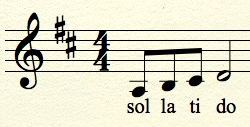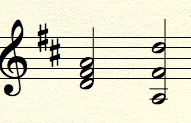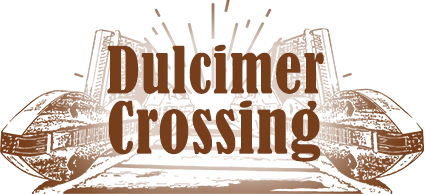Why use the DAA tuning?
by Steve Eulberg
With mountain dulcimer, every tuning has benefits to recommend it. Every tuning also has limitations.
Someone wrote to me recently to ask why we include lessons on the DulcimerCrossing website in the DAA tuning. Here are the 4 reasons that I wrote back in response:
 This tuning gives the player the notes below Do for "Plagal" tunes (like Amazing Grace, Holy Manna, Happy Birthday, e.g.) all on the melody string(s). This is most helpful for players who are not comfortable leaving the melody string(s). It is also required for playing these kinds of tunes that the lower octave when playing in the traditional noter style. (It is hard for most players to use the noter to play notes only on the middle string.) (I explored Plagal in an earlier post.)
This tuning gives the player the notes below Do for "Plagal" tunes (like Amazing Grace, Holy Manna, Happy Birthday, e.g.) all on the melody string(s). This is most helpful for players who are not comfortable leaving the melody string(s). It is also required for playing these kinds of tunes that the lower octave when playing in the traditional noter style. (It is hard for most players to use the noter to play notes only on the middle string.) (I explored Plagal in an earlier post.)
 This tuning also affords very comfortable fingerings for Close-harmonized chord voicings. This feature may be a little more complicated to explain, but let me give it a try. Close harmony is when you have all the notes in the chord as close to each other as possible, with no "gaps" between notes. (Close harmony is on the left, open or dispersed harmony is on the right. We'll talk about this in relation to both kinds of dulcimers in a future post.)
This tuning also affords very comfortable fingerings for Close-harmonized chord voicings. This feature may be a little more complicated to explain, but let me give it a try. Close harmony is when you have all the notes in the chord as close to each other as possible, with no "gaps" between notes. (Close harmony is on the left, open or dispersed harmony is on the right. We'll talk about this in relation to both kinds of dulcimers in a future post.)
With mountain dulcimer, every tuning has benefits to recommend it. Every tuning also has limitations.
Someone wrote to me recently to ask why we include lessons on the DulcimerCrossing website in the DAA tuning. Here are the 4 reasons that I wrote back in response:
1) Do-sol-sol or 1-5-5- (e.g. DAA) Tuning
1-5-5 is the most common original tuning for mountain dulcimers in the USA, and, on instruments with no 6+ or 6-1/2 fret, it is the only way to play the Ionian (Major) scale on the melody strings. The Ionian Mode or Major Scale is the one that most of the tunes played in the US are found. That scales goes from frets 3-10 (not playing the 6-1/2 fret).
DAA is the most common occurring version of this tuning at this point in history among players across the USA. (We'll explore how "D" came about as the basis for tuning mountain dulcimers in another post.)
2) Notes below "Do".
 This tuning gives the player the notes below Do for "Plagal" tunes (like Amazing Grace, Holy Manna, Happy Birthday, e.g.) all on the melody string(s). This is most helpful for players who are not comfortable leaving the melody string(s). It is also required for playing these kinds of tunes that the lower octave when playing in the traditional noter style. (It is hard for most players to use the noter to play notes only on the middle string.) (I explored Plagal in an earlier post.)
This tuning gives the player the notes below Do for "Plagal" tunes (like Amazing Grace, Holy Manna, Happy Birthday, e.g.) all on the melody string(s). This is most helpful for players who are not comfortable leaving the melody string(s). It is also required for playing these kinds of tunes that the lower octave when playing in the traditional noter style. (It is hard for most players to use the noter to play notes only on the middle string.) (I explored Plagal in an earlier post.)3) Close-Harmonized Chord Voicings.
 This tuning also affords very comfortable fingerings for Close-harmonized chord voicings. This feature may be a little more complicated to explain, but let me give it a try. Close harmony is when you have all the notes in the chord as close to each other as possible, with no "gaps" between notes. (Close harmony is on the left, open or dispersed harmony is on the right. We'll talk about this in relation to both kinds of dulcimers in a future post.)
This tuning also affords very comfortable fingerings for Close-harmonized chord voicings. This feature may be a little more complicated to explain, but let me give it a try. Close harmony is when you have all the notes in the chord as close to each other as possible, with no "gaps" between notes. (Close harmony is on the left, open or dispersed harmony is on the right. We'll talk about this in relation to both kinds of dulcimers in a future post.)4) Familiarity with other players.
There are many people who prefer this tuning, and a good number of clubs and groups who use it as their primary or only tuning. Some of them even use DAA in their club or group's name.
We'll explore in more depth the benefits and limitations of different tunings in other posts.
As always, if you have questions or comments, or you have some additional input, please let me know!
Categories
- News (6)
- Events (4)
- subscriber news (236)
- uncategorized (6)
- lessons (190)
- mountain dulcimer (203)
- hammered dulcimer (157)
- history (22)
- music theory (40)
- octave (1)
- plagal cadence (1)
- dulci-bro (73)
- fingerpicking (3)
- fingerstyle mountain dulcimer (4)
- nina zanetti (5)
- aeolian (2)
- dorian (4)
- ionian (3)
- lydian (1)
- mixolydian (3)
- modes (2)
- traditional (2)
- tuning (5)
- music education (2)
- NSME (1)
- standards (1)
- drone (3)
- folk alliance (1)
- jonah brody (1)
- koto (1)
- sam lee (1)
- scottish folk song (1)
- linda ratcliff (5)
- practice (29)
- chromatic mountain dulcimer (66)
- dulcimercrossing.com (2)
- erin rogers (7)
- building (8)
- black mountain (1)
- jerry read smith (1)
- Joshua Messick (1)
- song of the wood (1)
- don pedi (5)
- fiddle whamdiddle (9)
- miss mcleod (2)
- steve eulberg (30)
- vi wickam (9)
- buying (1)
- choosing (1)
- purchasing (1)
- orphan girl (1)
- copyright (1)
- amplification (2)
- contact pickup (1)
- eulberg (4)
- microphone (2)
- pickup (2)
- berkeley (1)
- colorado (2)
- festivals (4)
- kentucky (1)
- scholarship (1)
- western carolina (1)
- noter (2)
- clubfooted jib (1)
- dgd (2)
- dgd tuning (1)
- special event (31)
- david massengill (2)
- reverse ionian (1)
- chuck boody (1)
- concertina (1)
- deedee tibbits (1)
- dulcimer (7)
- evart (1)
- evart funfest (1)
- linda foley (1)
- michigan (1)
- original dulcimer players club (1)
- fingerstyle (11)
- gebhard woods (1)
- technique (1)
- harmonics (1)
- dan delancey (2)
- june apple (1)
- linda thomas (3)
- modal (1)
- expression (1)
- playing expressively (1)
- dulcimer pledge (1)
- christmas (2)
- nativity (1)
- DAC (2)
- minor more (1)
- mississippi sawyer (1)
- holiday (5)
- joy to the world (1)
- jingle bells (1)
- reverse ionion (1)
- hand independence (1)
- hand separation (1)
- lullabye of muffe (1)
- tina gugeler (1)
- absolute beginner mountain dulcimer (1)
- beginner (2)
- mountain (3)
- string-side up (1)
- absolute beginner hammered dulcimer (1)
- blog (2)
- dulcimercrossing. (1)
- topics (1)
- blues (4)
- resonator (4)
- dulcimer orchestra (2)
- kitty puss (1)
- mike clemmer (1)
- noter style (2)
- jam survival (7)
- butch ross (3)
- looping (1)
- intro (4)
- neal hellman (4)
- erin mae lewis (9)
- rehearsal (3)
- italian (1)
- lauda (1)
- irish (1)
- slipjig (1)
- rhythm (2)
- robert force (2)
- tuner (1)
- exercises (1)
- scales (1)
- devotions (3)
- hark advent (1)
- the glad sound! (1)
- chords (3)
- chromatic (4)
- erin (1)
- theory (7)
- advent (5)
- preparation (4)
- stir up (1)
- appalachia (4)
- hillbilly (1)
- mountains (1)
- traditional music (1)
- dampers (1)
- hearts of the dulcimer (3)
- patricia delich (2)
- wayne jiang (2)
- appalachian (1)
- John Jacob Niles (1)
- Live Events (28)
- Premium Level Membership (2)
- habits from the muse (1)
- progress (6)
- support (2)
- Anna Muckova (1)
- cimbalom (1)
- CWA (1)
- Czech Republic (1)
- Magdalena Muckova (1)
- nonsuch (1)
- Slovak Republic (1)
- podcast (1)
- aubrey atwater (2)
- jean ritchie (2)
- log-in (1)
- update (1)
- lucky (1)
- performance (9)
- preparing (1)
- study (1)
- dulcimers (1)
- wendy songe (2)
- bluegrass (2)
- growth (1)
- resolutions (2)
- risks (1)
- capo (1)
- snark (1)
- fiddle (61)
- criticism (2)
- judy klinkhammer (1)
- miles davis (2)
- wrong note (1)
- live and let live (1)
- style (1)
- barlow knife (1)
- old school old-time (2)
- marie kirby (1)
- bass mountain dulcimer (1)
- elaine conger (1)
- larry conger (1)
- practice smarter (8)
- musical journey (1)
- piano (1)
- calm (1)
- dog (1)
- su la li (1)
- bluebird cafe (1)
- inspiration (3)
- new input (2)
- trust (1)
- practice space (2)
- quite (1)
- how to practice (8)
- you are what you practice (1)
- workshop (5)
- rich chords (2)
- kaitlin pabo-eulberg (1)
- hooked on dulcimers (1)
- humor (1)
- blue water thinking (1)
- creativity (2)
- environment (2)
- original tunes (1)
- 1+ fret (1)
- chopin (1)
- classical (1)
- assessment (1)
- skill levels (1)
- waltz (1)
- caledonian club (1)
- ensemble (1)
- group (1)
- dulci-tune (1)
- tuning game (1)
- love (2)
- workout (1)
- learning (8)
- teacher (6)
- self-taught (1)
- how long (1)
- jam sessions (6)
- learn to play (1)
- strategies (2)
- fariña (1)
- mimi (1)
- pete seeger (2)
- rainbow quest (2)
- goals (1)
- planning (1)
- backing tracks (6)
- matthew dickerson (2)
- concert (1)
- erin mae (2)
- guitar (5)
- deborah hamouris (3)
- dj (2)
- freight and salvage (1)
- classic (1)
- licks (1)
- rock (1)
- berkeley dulcimer orchestra (1)
- premiere (1)
- banjo (1)
- frank proffitt (1)
- frank warner (1)
- tom dooley (1)
- baker (1)
- binding (1)
- blue lion (1)
- bob (1)
- gluing (1)
- janita (1)
- live (1)
- tips (1)
- spouse (1)
- amplified (1)
- DI box (1)
- digital interface (1)
- sound reinforcement (1)
- 2nd Set Concert (2)
- contest (1)
- flash mountain dulcimer brigade (2)
- JimJim & the FatBoys (1)
- Pecan Grove (1)
- walnut valley festival (2)
- winfield (1)
- wvfest (1)
- thinking (1)
- case (1)
- cross-legged (1)
- grip (1)
- safe dulcimer (1)
- sit (1)
- slip (1)
- stand (1)
- stool (1)
- strap (1)
- learn (3)
- mistakes (1)
- successes (2)
- herbie hancock (1)
- improvising (1)
- jazz (2)
- lois hornbostel (2)
- wrong chord (1)
- atlantic (1)
- barbara allen (1)
- frank profitt (1)
- scots-irish (1)
- chord wizard (1)
- diatonic (2)
- equi-distant (3)
- tom strothers (1)
- tool (2)
- busker (1)
- tsimbaly (1)
- ukraine (1)
- ukrainian (1)
- calendar (1)
- schedule (1)
- baritone (1)
- concert window (3)
- katie moritz (1)
- faq (1)
- frequently asked questions (1)
- logged in (1)
- navigation (1)
- old time (1)
- patreon (1)
- shape-note (1)
- special (1)
- carrell (1)
- geoff reeve-black (1)
- malvern (1)
- presnell (1)
- articulations (1)
- chicken reel (1)
- conger (1)
- soldier's joy (1)
- basic level membership (1)
- caring for your instrument (1)
- winter weather (1)
- god rest ye (1)
- rhythmic displacement (1)
- builder (1)
- tam kearney (1)
- toronto (1)
- don neuhauser (1)
- slide (1)
- ashley ernst (1)
- dan and angie landrum (1)
- dpn (1)
- dulcimer players news (1)
- dulcimersessions.com (1)
- maddie macneil (1)
- arkansas traveler (1)
- Mark Alan Wade (2)
- 3d playing (1)
- playing across the strings (2)
- chord symbols (1)
- understanding chords (3)
- dulcimer club (1)
- class (1)
- habits (1)
- skills (1)
- jimmy driftwood (1)
- failures (1)
- hours (1)
- youtube (1)
- arranging (1)
- bill robinson (1)
- cold winter night (1)
- karen mueller (3)
- jig (1)
- DAd tuning (1)
- hyfrydol (1)
- hymn (1)
- 2020 (1)
- premium (1)
- gounod (1)
- hitchcock (1)
- dan evans (1)
- spotted pony (2)
- steveeulberg (1)
- nylon-string (1)
- stephens lutherie (1)
- musical devotions (1)
- award (1)
- fernando sor (1)
- hammered (1)
- understanding (1)
- lent (1)
- leap forward (1)
- power of music (2)
- News (10)
- Events (4)
- mountain dulcimer (147)
- hammered dulcimer (151)
- chromatic mountain dulcimer (8)
- sharing (1)
- persistence (5)
- Practice (4)
- routine (1)
- tour (1)
- new website (1)
- arrranging (1)
- celtic (1)
- single jig (1)
- mountain dulcimer (3)
- busking (1)
- audio (1)
- playback (1)
- protection (1)
- adaptations (1)
- dulcimer acquisition syndrome (1)
- dulcimer acquisition disease (1)
- contests (1)
- lessons (1)
- identify (1)
- apps (1)
- motivation (1)
- hands (1)
- In Memoriam (1)
- guitar (1)
- archive (1)
- concerts (1)
- mountain dulcimer (2)
- hammered dulcimer (1)
- lessons (1)
- workshops (1)
- self-assessment (1)
- learn (1)
- greek (1)
- mindset (3)
- accountability (2)
- encouragement (1)
- prodding (1)


8 comments
Leave a comment
Please log in or register to post a comment